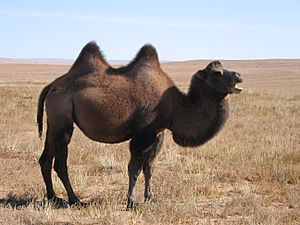Desert ecology facts for kids
Imagine a place with very little plant life, where the weather can be super dry or extremely hot. That's a desert! Desert ecology is all about studying how living things survive and thrive in these tough desert environments. Many plants and animals in the desert have amazing adaptations that help them deal with the harsh conditions.
Contents
What is a Desert?
Deserts are places that get very little rain. This means they are often very dry. Some deserts are also incredibly hot, like the Sahara Desert. Others, like the Gobi Desert, can be very cold, especially at night or in winter. Even though they seem empty, deserts are full of life!
How Do Animals Survive in the Desert?
Desert animals have special ways to cope with the heat and lack of water.
Staying Cool
Many desert animals are active at night when it's cooler. This is called being nocturnal. During the day, they might hide in burrows underground, where the temperature stays more steady. Some animals, like fennec foxes, have large ears that help them release body heat.
Finding and Saving Water
Water is super important in the desert. Animals get water in different ways:
- Some, like kangaroo rats, get all the water they need from the seeds they eat.
- Others, like camels, can drink a lot of water at once and store it. Camels also have bodies that can handle big changes in temperature, which helps them save water.
- Many desert animals have special kidneys that help them produce very little, concentrated pee, so they don't lose much water.
How Do Plants Survive in the Desert?
Desert plants, often called xerophytes, are also amazing at surviving with little water.
Storing Water
Many desert plants, like cacti, are succulents. This means they have thick, fleshy stems or leaves that store water. Think of them like natural water tanks!
Getting Water
- Some plants have very long roots that reach deep underground to find water.
- Others have wide, shallow root systems that can quickly soak up any rain that falls.
- Some plants have tiny leaves or no leaves at all to reduce water loss through evaporation.
Protecting Themselves
Many desert plants have spines or waxy coatings. Spines, like those on a cactus, protect them from animals that might want to eat them for their water. Waxy coatings help seal in moisture.
Desert Food Webs
Just like in any other place, deserts have food webs. Plants are the producers, making their own food using sunlight. Animals then eat the plants or other animals. For example:
- Cacti and desert shrubs are eaten by insects or small rodents.
- Snakes and owls might eat the rodents.
- Larger predators like coyotes might hunt snakes or bigger rodents.
Every living thing plays a part in keeping the desert ecosystem healthy.
Images for kids
-
Sand dunes in the Sahara Desert, one of the hottest places on Earth.






